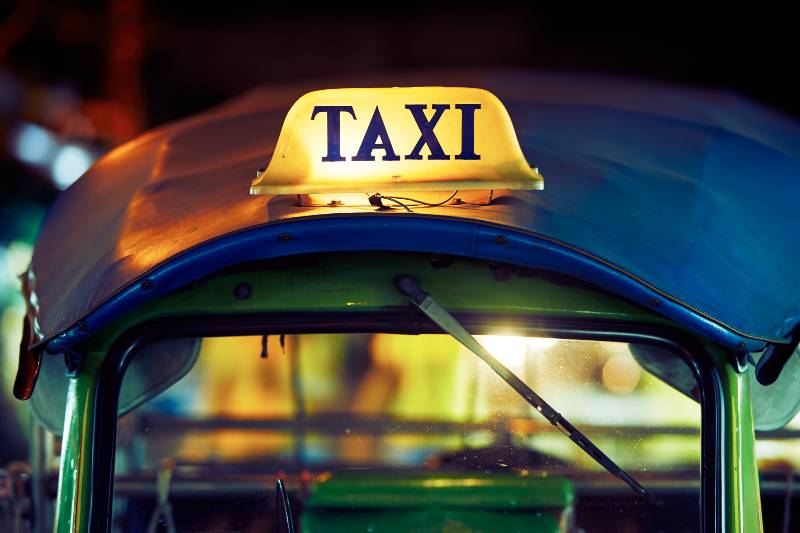The Thrifty Traveler’s Guide to Transportation in Thailand
Thailand is a dream travel destination for travelers from across the world. From the golden temples of Bangkok to its rich cultural heritage and incredibly delicious cuisine, there are endless opportunities to explore this Southeast Asian nation. But if you’re not ready or able to get around by car, don’t fret – there are myriad options available that will allow you to transport yourself throughout Thailand without white-knuckle driving. In this blog post, we’ll explain all your transportation choices so that you can make an informed decision and confidently get out and explore this incredible country!
The most common means of transportation for travel are taking the train, bus, and tuk-tuks. If you plan on island hopping in Thailand, then utilizing boats is also a popular option.
Key Takeaways
- Thailand has a well-developed network of public transportation, which includes buses, trains, and planes, allowing you to reach virtually any location in the country.
- Using ridesharing apps such as Grab can be a budget-friendly and efficient substitute for taking a taxi.
- There are other options available for transportation such as motorcycles, tuk-tuks, longboats, and bicycles.

Public Transportation Options
BTS Skytrain
Looking for a convenient and efficient way to navigate Bangkok’s bustling city streets? Look no further than the BTS Skytrain. This elevated rapid transit system is a top-rated experience among travelers, with an impressive 94% recommending it based on Tripadvisor reviews. And it’s easy to see why – the BTS Skytrain offers a quick and affordable way to explore the city, all while enjoying stunning views of Bangkok’s skyline. Plus, with nearby attractions like the famous Chatuchak Weekend Market and Siam Paragon shopping mall, there’s no shortage of things to do and see along the way.
MRT Subway
The system serves the Bangkok Metropolitan Region, with two rapid transit lines currently in operation and three more lines (including one rapid transit line and two monorail lines) currently under construction. The MRT is a popular choice among commuters and tourists alike, offering a fast and affordable way to navigate the city. Meanwhile, the BTS Skytrain is another option to consider, with an elevated rapid transit system that covers many of the city’s busiest areas.
Buses
Bangkok has a vast network of bus routes that can be overwhelming for those visiting for the first time. It is recommended to carry an MBTA map which can be obtained at most bus terminals. If you are unsure, you can ask a local or police officer for help or call 184, the BMTA Hotline for assistance.
Buses operate from 5 am to 11 pm daily, except for all-night ones. Regular buses cost approximately 8 baht, expressway buses cost 10 baht, and air-conditioned buses (cream-blue) start at 12 baht (depending on distance). All-night buses (cream-red) cost approximately 9.50 baht, while EURO II buses (yellow-orange) cost between 13 to 25 baht based on distance.
Tuk-Tuks
The vehicles called tuk-tuks are a newer alternative to cycle rickshaws, which Thai people refer to as “Sam Lor” because they have three wheels. Sam Lors were first seen in Thailand in 1933 but were banned from main roads due to safety concerns.
In Thailand, after 30 years, auto rickshaws were imported from Japan to replace cycle rickshaws. The unique name “tuk tuks” given to Thailand’s auto-rickshaws is believed to have originated from the sound their engines make.
Motorbike Taxis
In Thailand, motorbike taxis are easy to identify. The drivers wear orange vests with their ID numbers and display their professional cards with their names and photos on the back.
99% of motorbike taxis are driven by men.
In the Thai capital, motorbike taxis are plentiful and can be found on nearly every street corner. These drivers typically cluster together in groups of four or five and take turns picking up customers.
Drivers have a significant advantage in that they have an excellent knowledge of their neighborhood. They can provide accurate directions if you are searching for a specific location. In many cases, their directions are more accurate than GPS, and they possess a wealth of knowledge about the community.
Alternative Transportation Methods
Cycling
With the environmental challenges faced today, biking has become a popular and eco-friendly solution for alternative transportation. Cycling offers numerous benefits beyond being a great way to exercise. Not only is it cost-effective, but it also reduces traffic congestion and air pollution. Plus, cycling does not require a fuel source, making it a sustainable mode of transportation. Moreover, cycling is a fun and enjoyable experience that allows you to appreciate the environment and scenery around you.
Walking
As concerns for the environment and health grow, so does the search for alternative transportation methods. One of the most basic and accessible ways to get around is simply walking. Not only does walking reduce one’s carbon footprint, but it also has a plethora of physical and mental health benefits. A leisurely stroll can help clear the mind, reduce stress, and improve overall well-being. Plus, it’s a great way to discover new areas and get some fresh air. Whether it’s walking to work or taking a stroll on the weekends, this alternative method of transportation can have a significant impact on both personal and planetary health.
Boat Rides
Alternative transportation methods are becoming increasingly popular as people look for ways to reduce their carbon footprint and enjoy a more sustainable lifestyle. One option that should be considered is taking a boat ride. Boat rides not only provide a unique and enjoyable way to travel, but they also offer stunning views of the world’s waterways and natural beauty. Whether it’s a leisurely river cruise or a day out on the open ocean, taking a boat ride can be a memorable and relaxing way to get from one point to another. Plus, it’s a great opportunity to learn about the history and culture of the area from an experienced and knowledgeable captain.
Grab/Taxis
One such alternative is the use of ride-sharing services like Grab or taxis. These services offer a convenient way to get from one place to another, without the hassle of driving and finding parking. They also provide passengers with a sense of safety and confidence, thanks to their reliable drivers and top-notch security features. Whether you’re commuting to work, going shopping, or simply exploring a new city, booking a ride with Grab or a taxi can be a smart and sustainable choice.
Train
Whether you’re commuting to work or heading out for a weekend getaway, trains provide an efficient mode of transportation with fewer traffic jams and less stress. In addition, trains are more environmentally friendly than driving a car, emitting fewer greenhouse gases and consuming less energy. With comfortable seating and scenic views, taking the train is not only a practical choice, but a pleasant one too.
Tips for Getting Around
Avoiding Rush Hour
Thailand is a country bustling with activity, which means it’s important to plan your commute accordingly. There’s nothing worse than getting stuck in a traffic jam during rush hour in Thailand! In order to avoid this, it’s best to plan your transportation during non-peak hours. This will not only save you time but also ensure a stress-free commute. In addition, try to use public transportation as much as possible. The BTS Skytrain and MRT subway are great options for getting around the city quickly and affordably. Also, don’t forget to download a ride-sharing app on your phone to hail cabs or motorbikes easily.
Learning Basic Thai Phrases
As a foreigner traveling to Thailand, getting around can be quite an adventure. One of the most helpful tips to successfully navigating this beautiful country is learning basic Thai phrases. While English is spoken in tourist areas, many locals appreciate it when visitors attempt to speak their language. Simple phrases such as “hello,” “thank you,” and “excuse me” can go a long way in establishing a friendly connection with the Thai people. Not only will learning a few phrases make communication easier, but it can also lead to new friendships and experiences.
Keeping Cash on Hand
Thailand is a country that is rich in culture, history, and attractions, making it a popular destination for many travelers. When it comes to getting around in Thailand, it is essential to keep some cash on hand as not all places accept credit cards. While there are ATMs throughout the country, it’s always good to have some backup cash in case of emergencies or if you find yourself in an area without ATM access. When exchanging currency, it’s best to do so at banks or official exchange centers to avoid scams or counterfeit money.
Being Aware of Scams
As you plan your trip to Thailand, it’s important to be aware of scams that may occur while you’re getting around. While the majority of people you’ll meet in Thailand are friendly and welcoming, there are unfortunately a few who may try to take advantage of tourists. One common scam involves tuk-tuk drivers offering to take you on a sightseeing tour for an incredibly low price, only to take you to a series of shops where they receive a commission for getting you to buy something. To avoid this, make sure to agree on a price before getting in any type of transportation and always research potential scams ahead of time.
Staying Safe
Getting around in Thailand can be an exciting adventure, but it’s important to prioritize safety when exploring a new country. One tip to keep in mind is to always carry a copy of your passport and visa with you, while keeping the originals in a secure place. It’s also a good idea to be aware of your surroundings and avoid unlit or unfamiliar areas, especially at night. Tuk-tuk drivers and street vendors may offer very inexpensive rates for transportation or goods, but it’s important to exercise caution when interacting with them.
How To Get Around Thailand Without a Car FAQs
Is it easy to get around Thailand without a car?
Traveling around Thailand is generally hassle-free and uncomplicated. Many visitors follow similar routes, so there are well-established modes of transportation such as planes, trains, buses, and ferries that connect popular cities.
What is the most affordable way to get around Thailand?
Bus travel is a faster and more efficient option than taking the train to get to any province in Thailand. You can choose from various bus routes, ranging from smaller villages to bigger cities, offering maximum flexibility while traveling across the country.
Can I rent a bike or scooter in Thailand?
In Thailand, renting a scooter is reasonably priced. The cost may vary depending on the location, with daily rates typically falling between TBH 150 and 300.
Are taxis safe to use in Thailand?
Traveling short to medium distances in Thailand can be safest and most efficient using taxis. To minimize any potential risks, it is advisable to avoid taxis charging a flat rate and to ensure that the meter reads “35” upon entering.
What is the best way to get to the tourist spots in Thailand?
When traveling long distances in Thailand, buses are the best option. Trains are available, but not all tourist destinations are connected by the railway. If you’re visiting Bangkok, the most common way to get around is by using a Tuk-tuk, which should definitely be on your list of things to try in the city.
Conclusion
Now that you have the skinny on getting around Thailand without a car, it’s time to give it a go! Traveling around Thailand by train, bus, bike, and motorbike can be an incredibly rewarding experience. Not only will you save money, but you’ll also get to see and connect with many interesting people along your journey. If you’re worried about the language barrier, get out there and practice your Thai skills! You never know who or what you might run into during your travels. And don’t forget- try to accommodate cultural norms as best as possible for both yourself and the locals.
In addition to reading this article on how to get around Thailand without a car, make sure you subscribe to our newsletter for the best information about living in Thailand.


